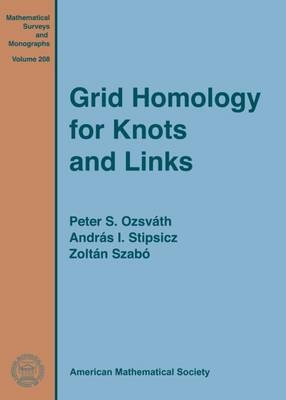
Grid Homology for Knots and Links
Seiten
2015
American Mathematical Society (Verlag)
978-1-4704-1737-6 (ISBN)
American Mathematical Society (Verlag)
978-1-4704-1737-6 (ISBN)
- Titel erscheint in neuer Auflage
- Artikel merken
Starting from the combinatorial point of view on knots using their grid diagrams, this book serves as an introduction to knot theory. After a brief overview of the background material in the subject, the book gives a self-contained treatment of knot Floer homology from the point of view of grid diagrams.
Knot theory is a classical area of low-dimensional topology, directly connected with the theory of three-manifolds and smooth four-manifold topology. In recent years, the subject has undergone transformative changes thanks to its connections with a number of other mathematical disciplines, including gauge theory; representation theory and categorification; contact geometry; and the theory of pseudo-holomorphic curves.
Starting from the combinatorial point of view on knots using their grid diagrams, this book serves as an introduction to knot theory, specifically as it relates to some of the above developments. After a brief overview of the background material in the subject, the book gives a self-contained treatment of knot Floer homology from the point of view of grid diagrams. Applications include computations of the unknotting number and slice genus of torus knots (asked first in the 1960s and settled in the 1990s), and tools to study variants of knot theory in the presence of a contact structure. Additional topics are presented to prepare readers for further study in holomorphic methods in low-dimensional topology, especially Heegaard Floer homology.
The book could serve as a textbook for an advanced undergraduate or part of a graduate course in knot theory. Standard background material is sketched in the text and the appendices.
Knot theory is a classical area of low-dimensional topology, directly connected with the theory of three-manifolds and smooth four-manifold topology. In recent years, the subject has undergone transformative changes thanks to its connections with a number of other mathematical disciplines, including gauge theory; representation theory and categorification; contact geometry; and the theory of pseudo-holomorphic curves.
Starting from the combinatorial point of view on knots using their grid diagrams, this book serves as an introduction to knot theory, specifically as it relates to some of the above developments. After a brief overview of the background material in the subject, the book gives a self-contained treatment of knot Floer homology from the point of view of grid diagrams. Applications include computations of the unknotting number and slice genus of torus knots (asked first in the 1960s and settled in the 1990s), and tools to study variants of knot theory in the presence of a contact structure. Additional topics are presented to prepare readers for further study in holomorphic methods in low-dimensional topology, especially Heegaard Floer homology.
The book could serve as a textbook for an advanced undergraduate or part of a graduate course in knot theory. Standard background material is sketched in the text and the appendices.
Peter S. Ozsvath, Princeton University, NJ, USA. Andras I. Stipsicz, Renyi Institute of Mathematics, Budapest, Hungary. Zoltan Szabo, Princeton University, NJ, USA.
Introduction
Knots and links in $S^3$
Grid diagrams
Grid homology
The invariance of grid homology
The unknotting number and $/tau$
Basic properties of grid homology
The slice genus and $/tau$
The oriented skein exact sequence
Grid homologies of alternating knots
Grid homology for links
Invariants of Legendrian and transverse knots
The filtered grid complex
More on the filtered chain complex
Grid homology over the integers
The holomorphic theory
Open problems
Homological algebra
Basic theorems in knot theory
Bibliography
Index
| Erscheinungsdatum | 08.01.2016 |
|---|---|
| Reihe/Serie | Mathematical Surveys and Monographs |
| Verlagsort | Providence |
| Sprache | englisch |
| Maße | 178 x 254 mm |
| Themenwelt | Mathematik / Informatik ► Mathematik ► Geometrie / Topologie |
| ISBN-10 | 1-4704-1737-5 / 1470417375 |
| ISBN-13 | 978-1-4704-1737-6 / 9781470417376 |
| Zustand | Neuware |
| Haben Sie eine Frage zum Produkt? |
Mehr entdecken
aus dem Bereich
aus dem Bereich
Gekrümmte Kurven und Flächen
Buch | Softcover (2024)
De Gruyter (Verlag)
54,95 €
Nielsen Methods, Covering Spaces, and Hyperbolic Groups
Buch | Softcover (2024)
De Gruyter (Verlag)
109,95 €


